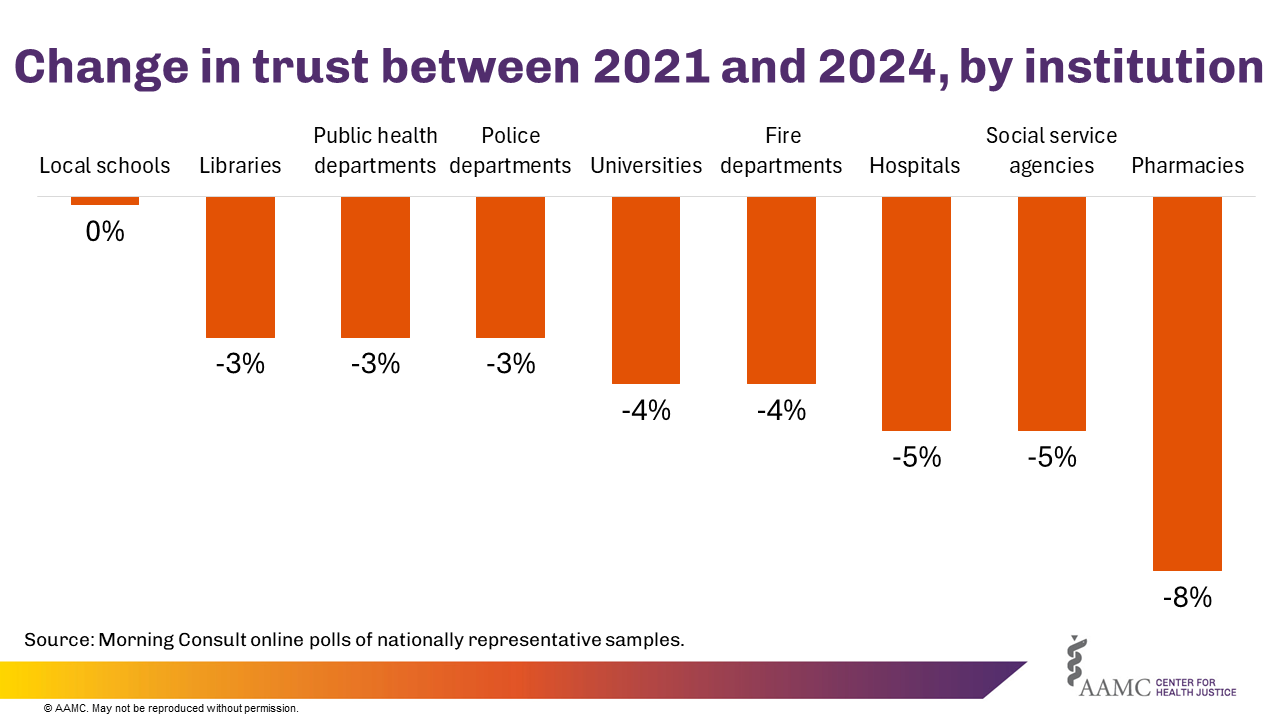Institutions' Role in Building Trust and Health Equity
Institutions play a critical role in shaping societal behavior and delivering resources — such as education, health care, and social programs — to communities. With their influence and resources, institutions have a responsibility to demonstrate trustworthiness to the communities they serve, to ensure effective engagement in fair and equitable opportunities for health and well-being.1 2 A lack of trust in institutions may negatively impact a person’s willingness to access critical resources or services within their communities.3 Many groups — including racial or ethnic minority groups, sexual and gender minorities, and people with disabilities — frequently experience unjust systemic disadvantages4 that contribute to poorer health outcomes.5 These groups are also often less trusting of organizations6 and have often experienced unethical treatment (e.g., racism, discrimination, ableism), which erodes trust. To achieve health equity, a state in which everyone has a fair and just opportunity to attain their highest level of health,7 improving trust is vital.8
The AAMC Center for Health Justice is committed to helping organizations and institutions build trust and advance health equity in collaboration with community partners. In 2020, the Center and the AAMC Collaborative for Health Equity: Act, Research, Generate Evidence (AAMC CHARGE) established a three-way partnership that prioritized community perspectives and the lived experiences of 30 community members who represented different backgrounds and multiple regions across the United States. This unique partnership culminated in the development of the Principles of Trustworthiness Toolkit. Initially developed in response to national concerns around trust in clinical trials and vaccines, the Principles of Trustworthiness Toolkit provides guidelines, discussion questions, and activities that organizations can use to determine which actions would demonstrate that they are worthy of their community’s trust.9
In December 2021, the Center published The State of Trustworthiness, a polling brief describing U.S. adults’ levels of trust in institutions representing various sectors (including public health, health care, education, and social services among others) and how trust changed during the COVID-19 pandemic. From 2022 through 2024, the Center conducted three additional polls that asked respondents to rate how much they trusted each of the following institutions to serve everyone in their local community fairly:10
This brief presents trust-related findings from those polls, provides insights into changes in trust over time, and provides information on the demographic subgroups that report lower levels of trust.
Trusted Institutions
Across all polls, most (> 67%) U.S. adults reported that they trust the nine institutions presented in the survey to serve everyone in their local community fairly (Figure 1). Fire departments and libraries were consistently the most trusted, and social service agencies were the least trusted (Figure 1 and Supplemental Table 1). Survey respondents described fire departments as “ready to assist,” while social service agencies were described as insufficiently staffed and lacking quality customer service. Previous research has reported that, although not directly assessed in our polls, the higher levels of trust in fire departments and libraries may be associated with the wide range of interactions and services these entities provide in local communities, such as hosting community events and providing education and resources.11 12 13 14
Trust in Institutions Is Declining
From 2021 to 2024, there was a gradual decline in trust reported for eight of nine sectors, with local schools as the exception (Figure 1). Pharmacies experienced the sharpest decline in trust (8% decrease), followed by hospitals and social service agencies (5% decrease), fire departments and universities (4% decrease), and police departments, public health departments and libraries (3% decrease) (Figure 2). Other studies have reported reductions in public trust in the government and other institutions, based on analysis prior to the COVID-19 pandemic.15 Since the pandemic, several studies have reported further reductions in trust, which have been attributed to inconsistent public health management, political polarization, the spread of mis- and disinformation through social media, systemic inequality, and pandemic fatigue.16 17 18 19
Who Reports Lower Levels of Trust?
While members of Gen Z (born 1997-2012) reported lower levels of trust across most institution types assessed (eight of nine), other demographic groups reporting low levels of trust varied by sector (Table 1). For example, adults who live in rural areas, those with lower annual incomes (less than $50,000), and individuals who have less than a college degree reported lower levels of trust in hospitals, as compared with their counterparts. Respondents with less than a college degree reported lower levels of trust in pharmacies. Conservative adults were less likely to trust public health departments, while Black and Hispanic adults, liberals, adults with lower annual incomes, and those living in urban communities reported lower levels of trust in police departments. These findings highlight the need to include diverse communities’ perspectives in organizational efforts to address trustworthiness.
Table 1. Lower levels of trust, by type of institution and demographic group
| Demographic characteristic | Hospitals | Pharmacies | Public health departments | Social service agencies | Fire departments | Police departments | Libraries | Universities | Local schools |
|---|---|---|---|---|---|---|---|---|---|
| BlackA | X | X | X | ||||||
| HispanicB | X | X | X | ||||||
| ConservativeC | X | X | X | ||||||
| LiberalC | X | ||||||||
| RuralD | X | ||||||||
| UrbanD | X | ||||||||
| Gen ZE | X | X | X | X | X | X | X | X | |
| Income less than $50,000F | X | X | X | ||||||
| Less than a college degreeG | X | X | X | X | X |
Significance level for all demographic characteristics listed above was p<0.05 from 2021-2024.
A Black adults vs. white adults (reference group)
B Hispanic adults vs. white adults (reference group)
C Conservatives vs. liberals (reference group)
D Rural adults vs. urban adults (reference group)
E Gen Zers vs. baby boomers (reference group)
F Income of less than $50,000 vs. more than $100,000 (reference group)
G Education less than college degree vs. postgraduate degree (reference group)
Future work
The path to demonstrating and preserving trustworthiness requires establishing and maintaining long-term, bidirectional community relationships, the implementation of collaborative decision-making, and the evaluation of the authenticity and impact of community engagement activities.20 Institutions should invest in community engagement and the application of frameworks, such as the Principles of Trustworthiness, the Centers for Disease Control and Prevention’s Principles of Community Engagement, which recently added “trustworthiness” as a new, 10th principle, and the National Academies’ Assessing Community Engagement Conceptual Model and related assessment tools for community engaged activities. These frameworks provide strategies to promote health equity and practical guidance for authentically engaging community partners.
The survey findings highlight that communities are not monoliths and that tailored community engagement to build trust is needed. For example, in higher education, trust-building requires demonstrating reliability, capability, integrity, and benevolence.21 These activities can be operationalized with the community to ensure co-creation and instill pride and ownership. In the health care sector, for institutions that seek to demonstrate trustworthiness in rural communities, new health care service delivery models centered on rural needs and meaningful inclusion of rural perspectives are necessary.22 Key steps for implementation include partnering with trusted local community leaders who can disseminate information to the community directly, providing resources and services within trusted community areas (e.g., barbershops, places of worship).23 Additionally, “the identification of ‘community leaders’ must be guided by communities themselves to ensure they meaningfully represent the views of these groups.”24 To extend these steps in tangible ways, organizations can offer training on how to effectively partner with communities, employ policies that reward relationship building, and ensure formal accountability.
By embracing collaborative action, institutions can foster transformation that honors community voices, nurtures meaningful relationships, and creates a future where trust leads to health and health equity for all communities.
Access the supplemental tables for this brief (PDF)
- Principles of Trustworthiness Toolkit Project. Center For Health Justice. https://www.aamchealthjustice.org/our-work/trustworthiness/project. Accessed Jan. 28, 2025. Back to text ↑
- McHugh MK, Alper J, editors. The Roles of Trust and Health Literacy in Achieving Health Equity: Community Settings: Proceedings of a Workshop — in Brief. Washington, D.C.: National Academies Press; 2023. Back to text ↑
- Griffith DM, Bergner EM, Fair AS, Wilkins CH. Using mistrust, distrust, and low trust precisely in medical care and medical research advances health equity. Am J Prev Med. 2021;60(3):442-445. Back to text ↑
- Brown AF, Ma GX, Miranda J, et al. Structural Interventions to reduce and eliminate health disparities. Am J Public Health. 2019;109(S1):S72-S78. Back to text ↑
- Williamson TJ, Mahmood Z, Kuhn TP, Thames AD. Differential relationships between social adversity and depressive symptoms by HIV status and racial/ethnic identity. Health Psychol. 2017;36(2):133-142. Back to text ↑
- Ojikutu BO, Bogart LM, Dong L. Mistrust, empowerment, and structural change: lessons we should be learning from COVID-19. Am J Public Health. 2022;112(3):401-404. Back to text ↑
- What is health equity? Centers for Disease Control and Prevention. https://www.cdc.gov/health-equity/what-is/index.html. Published June 11, 2024, Accessed Jan. 28, 2024. Back to text ↑
- McHugh MK, Alper J, editors. The Roles of Trust and Health Literacy in Achieving Health Equity: Community Settings: Proceedings of a Workshop — in Brief. Washington, D.C.: National Academies Press; 2023. Back to text ↑
- Chinekezi O, Andress L, Agonafer EP, et al. From the national to the local: issues of trust and a model for community-academic-engagement. Front Public Health. 2023;11:1068425. Back to text ↑
- All four polls of U.S. adults ages 18-65+ were conducted by Morning Consult for the Center of Health Justice in 2021-2024 (sample sizes: 2021 n=2,200, 2022 n=2,201, 2023 n=6,748, 2024 n=2,201) and were weighted to approximate a nationally representative sample based on gender, age, education, race, and region. Polls were conducted using an online survey in English through multiple nationally recognized vendors. Our analyses dichotomized levels of trust into two categories: 1. high (a lot and a little) and 2. low (not much and not at all). Back to text ↑
- Cameron DB, Grage L, Van Wyck R, et al. Identifying trusted local sources and predicting behavior change pathways according to COVID-19 vaccination status: results of a 2022 statewide survey of Alaskan adults. Vaccine. 2024;42(10):2592-2607. Back to text ↑
- Keller BM, Cunningham TR. Firefighters are distributors of workplace safety and health information to small businesses. Saf Sci. 2016;87:87-91. Back to text ↑
- Meischke H, Diehr P, Rowe S, Cagle A, Eisenberg M. A community Intervention by firefighters to Increase 911 calls and aspirin use for chest pain. J Acad Emerg. 2006;13(4):389-395. Back to text ↑
- Wojciechowska M. Trust as a factor in building cognitive social capital among library workers and users. Implications for library managers. J Acad Librariansh. 2021;47(1):102300. Back to text ↑
- Blendon RJ, Benson JM. Trust in medicine, the health system, & public health. Daedalus. 2022;151(4):67-82. Back to text ↑
- Robinson SE, Gupta K, Ripberger J, et al. Trust in Government Agencies in the Time of COVID-19. https://www.cambridge.org/core/product/1AF9B3662321F63AFBBD17321925D3A9. Cambridge, U.K.: Cambridge University Press; 2021. Back to text ↑
- Latkin CA, Dayton L, Strickland JC, Colon B, Rimal R, Boodram B. An assessment of the rapid decline of trust in U.S. sources of public information about COVID-19. J Health Commun. 2020;25(10):764-773. Back to text ↑
- SteelFisher GK, Findling MG, Caporello HL, et al. Trust In U.S. federal, state, and local public health agencies during COVID-19: responses and policy implications. Health Aff. 2023;42(3):328-337. Back to text ↑
- Geisterfer-Black M, Niemi T, Neier L, Rodwin VG. Trust in the U.S. government and its health agencies in the time of COVID-19. Epidemiologia (Basel). 2022;3(2):148-160. Back to text ↑
- Alberti, PM, Piepenbrink S. The state of trustworthiness. AAMC Center for Health Justice. www.aamchealthjustice.org/news/polling/state-trust. Published Dec. 16, 2021. Accessed Jan. 28, 2025. Back to text ↑
- Law SF, Le AT. A systematic review of empirical studies on trust between universities and society. J High Educ Policy Manag. 45.4 (2023): 393-408. Back to text ↑
- Citrin J, Stoker L. Political trust in a cynical age. Annu Rev Polit Sci. 2018;21(1):49-70. Back to text ↑
- Davids J, Maceda-Maria E, Ho K, Randall S, Feltner F, Parker AM. On trust and trustworthiness: listening to community leaders. Journal of Communication in Healthcare. 2023/10/02 2023;16(4):339-343.
Back to text ↑ - Hussain B, Latif A, Timmons S, Nkhoma K, Nellums LB. Overcoming COVID-19 vaccine hesitancy among ethnic minorities: a systematic review of U.K. studies. Vaccine. 2022;40(25):3413-3432. Back to text ↑



